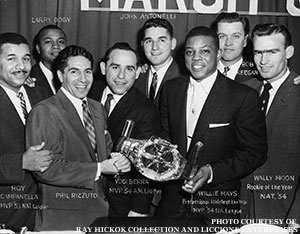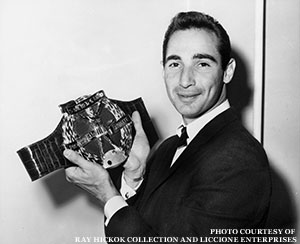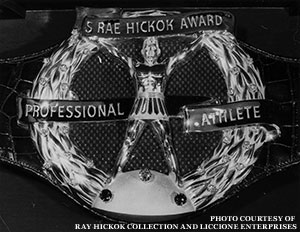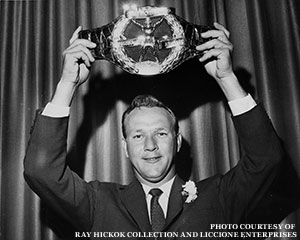
It was so gorgeous, encrusted with jewels and diamonds, that it put just about all other sports trophies to shame.
Maury Wills, the 1962 National League MVP, loved the Hickok Belt so much that he hid it in a box in his closet and worried about it constantly.
The speedy Los Angeles Dodgers shortstop would wake out of a dead sleep in the middle of the night, dash to his closet, and find the box just to make certain the belt was safe.
"When I would go out of town," Wills says, "I would come home to make sure it was still there. I even put it under my mattress just to keep it close to me.
"That's how much it meant to me."
It wasn't just him. Arnold Palmer won it. So did Mickey Mantle. And Joe Namath. And Willie Mays. It was the Heisman Trophy of pro sports, valued between $90,000 and $140,000 in today's money.
And yet it vanished from America's sporting landscape for 35 years.
But thanks to a boxing promoter who grew up dreaming of the Hickok Belt as a boy in the 1950s in Rochester, N.Y. -- the belt's original home -- a crown jewel is making a comeback.

As a young boy growing up in the 1950s, Tony Liccione also lay awake at nights thinking of the Hickok Belt -- an alligator skinned spectacle encrusted with the most precious of stones -- awarded annually in Rochester to the professional athlete of the year.
But when a series of circumstances led to the award ceremony being disbanded after Oakland Raiders quarterback Ken Stabler won what appeared to be the final belt in 1976, Liccione hatched a plan to bring it back.
"This was the most coveted Crown Jewel of all time," says Liccione. "We deserve to get it back for America and we deserve to get it back for Rochester."
Thanks to Liccione, now president of his hometown's Boxing Hall of Fame, Rochester finally has its belt back. And next year, so will the nation.
To understand why Liccione has spent the past three years fighting to revive the Hickok Belt is to realize what the Belt means to Rochester in the first place.
Ray Hickok was only in his 20s when he was unexpectedly handed the reins of his father's company, Hickok Manufacturing Co., when S. Rae Hickok died suddenly in 1945. S. Rae Hickok was a passionate sportsman whose appreciation for athletic achievement was never limited to a single endeavor.
So when Ray Hickok sought a way to honor his father, he conceptualized an award honoring the country's top athlete. Hickok commissioned four Hickok employees to create the belt, requiring 250 man-hours over six months. What came out of their efforts was a championship belt that included a 2 ½ carat diamond, a 2 ½ carat ruby, a 2 ½ carat sapphire and an 18-karat gold buckle.

"That belt meant everything to my father," says Holly Lang, the oldest child of Ray Hickok. "It was something that stood for all of the athletes in all sports. It wasn't just football players or golfers. (The belt) brought things to a different pinnacle because it meant so much to those who received it."
As much as the belt would honor athletes spanning the sporting spectrum starting in 1950 with New York Yankees' shortstop Phil Rizzuto, the Hickok Belt became Ray Hickok's way of continuing his father's legacy.
Ray grew up hunting, finishing and playing tennis, carrying on a love for all sports like his father had before him.
So rather than limiting the scope of the annual award to one sport, Hickok commissioned a panel of sportswriters to vote on an athlete of the month, culminating in an annual award each year at the Rochester Press-Radio Club.
"It meant you were the best athlete that year and it was really something," says former Yankees pitcher, "Bullet" Bob Turley, who won the belt in 1958. "I had won the monthly award two or three times that year but I saw who I was up against, and I thought, 'Hell, how can I beat those guys?'
"So when I got the belt, it was really something. It really was."
As much as it meant to those who received it, some Hickok Belt winners experienced a downside from capturing the award.
Because of the value of the belt, recipients were taxed by the IRS, which considered the belt taxable income.

Wills, who won the Hickok Belt in 1962 after stealing 104 bases to break Ty Cobb's record, tried have the belt classified as non-taxable income. He ended up losing his case in court. Other recipients had the jewels taken out of the belt and made into jewelry for their wives. Some belts were sold at auction. Some winners -- including Yankees' slugger Mickey Mantle -- kept the belt, commemorating one of the biggest achievements of their careers.
Wills ended up giving the belt to a friend who ran a casino in Las Vegas, where the belt was displayed prominently behind a glass display case. Visitors marveled at the belt's beauty all the way up to the day it was stolen.
Even though it's gone, Wills still considers winning the Hickok Belt one of his greatest achievements.
"The memory lingers with me with that belt," he says.
Over the years, the recipient list came to read like a Who's Who of sports heroes, ranging from boxer Rocky Marciano (1952) to golfer Ben Hogan (1953) to the belt's first international winner in 1959, when boxer Ingemar Johansson won it after defeating heavily-favored Floyd Patterson to capture the heavyweight title.
For Ray Hickok's children, the award took on personal meaning. In addition to hosting the annual awards dinner, recipients dined privately with Hickok and his family. The occasion afforded Hickok's children to not only meet star athletes, but to share in their father's tribute to his dad.
Before each dinner, Ray Hickok sat his children down and quizzed them about that year's recipient's accomplishments.
"At the dinner table, we discussed all the different athletes and my father expected us to know all about them," Lang says. "It was so personal for our family, but we got to know some of their stories."
In 1961, Ray, Jr. filled in for his father at the ceremony after the elder Hickok suffered a heart attack. In one of Holly's favorite moments, her brother -- who was killed in a car accident six years later along with her other brother, Christopher -- presented the belt to Roger Maris.
"I don't think my brother's feet hit the ground for six months," Lang says.

The fatal accident that killed two of Ray Hickok's sons began a string of sadness for the Hickok family. The Hickok Company struggled in tough economic times before being purchased by the larger Tandy Corp.
In 1971, Tandy continued the belt ceremony, but moved it out of Rochester to bigger cities like Chicago and New York in an effort to create more buzz about the award.
Before long, though, company executives shifted their focus to other matters, ending the belt's reign in 1976 when Stabler became the final winner.
"It was an enormously sad time," Lang says. "I saw it as a passing of an era."
Liccione, for one, was determined to bring it back.
For 15 years, Liccione considered the possibilities. Growing up, his family couldn't afford to attend the lavish banquets that honored the Hickok Belt winners, but that didn't keep Liccione from dreaming.
In 2008, Liccione purchased the trademark for the belt and began working to make it a reality again. Since then, he has partnered with local officials and the Fergie Jenkins Foundation, pushing to have the belt awarded on a yearly basis starting in 2012.

Liccione, along with officials from the National Association of Sportswriters and Sportscasters, established a system in which 1,000 media members will vote on monthly award winners before one honoree will be awarded a new Hickok Belt in Rochester next year.
Organizers are still working on a prototype of the belt, which Liccione hopes will resemble the lavish belt designed more than half a century ago. Now on the cusp of seeing years of work pay off, Liccione is ready to finish the fight strong.
"This is something I have always wanted to do for Rochester," Liccione says. "I'm stunned that it's happening, but to bring it back to Rochester and once again -- for one night a year -- make Rochester the capitol of the sports world -- is very special for me."
The kickoff ceremony, held this weekend, brought several recipients back to Rochester. Turley, who was honored with the award after posting a 21-7 record and winning the Cy Young Award in 1958, still reveres the old belt.
"It's probably the biggest honor you could get," says Turley, who was given the award in a year when Arnold Palmer and Wilt Chamberlain were also up for the honor. "You are the top professional athlete in the world and that's something."

Lang traveled from her home in northern Wisconsin. She admits that years ago, bringing the belt back may have been bittersweet considering everything that has happened to her family over the years.
But now, she feels differently, understanding what the return of the Hickok Belt would mean to her father.
"Enough years have passed and now, I just feel joy and I think he would be touched," Lang says. "He was always such a humble guy and for more than 50 years for it to be coming back just means so much to Rochester and to my family."
And next year, after all this time, it will once again mean the world to a new athlete.
-- Jeff Arnold can be reached at jeffarnold24@gmail.com, or follow him on Twitter @jeff_arnold24.
Popular Stories On ThePostGame:
-- Throwable Ball Camera May Revolutionize How We Watch Sports
-- Traditional Chinese Medicine Helps Paralyzed Bodybuilder Walk Again
-- Bullying Victims Fight Back With Help From Brazilian Jiu-Jitsu Royalty




